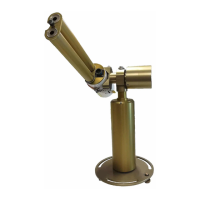CE318-T Photometer
User Operation Manual
Revision V4.10 October 2021
13
1.3. Sensor head types
6 different sensor head types exist:
• Standard / CE318-TS9: It uses 340, 380, 440, 500, 675, 870, 937, 1020 and
1640 nm filters (Fig.1).
• Polarized / CE318-TP9: A filter wheel containing 3 sets of 3 polarizers
operating in infrared (POL1), Ultraviolet (POL2), and visible (POL3) and which
are orientated with a 120° angle is added on top of the wheel containing the
Standard filters. Additional information about the aerosols nature and shapes
can then be retrieved (Fig.2).
• BRDF / CE318-TU9: it uses 380, 440, 550, 675, 740, 870, 937, 1020 and
1640 nm filters (Fig.3).
• BRDF 12 filters / CE318-TU12: It is designed for satellite calibration. It uses
415, 440, 490, 555, 675, 702, 740, 782, 870, 937, 1020, 1640 nm filters
(Fig.4).
• Ocean Color (OC) 12 filters / CE318-TV12-OC / SeaPRISM: It uses 400,
412.5, 442.5, 490, 510, 560, 620, 665, 779, 865, 937, 1020 nm filters (Fig.5)
• Lake Color (LC) 12 filters / CE318-TV12-LC: It uses 412.5, 442.5, 490, 510,
560, 620, 665, 681, 709, 865, 937, 1020 nm filters (Fig.6)
The sensor head types differ in the presence of an additional wheel filter containing
polarizers for the Polarized type, the filters wavelengths mounted in the head sensor,
and the scenario sequence established.
Filter wavelengths are defined in the UV-visible-IR spectrum according to scientific
retrieval purposes.
The filters and polarizers curves are delivered with the photometer.

